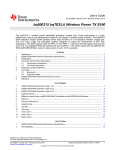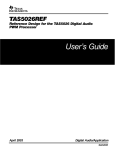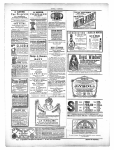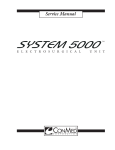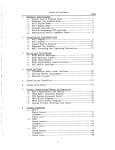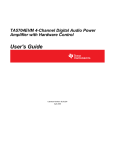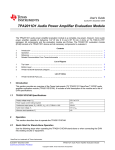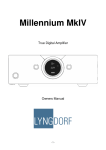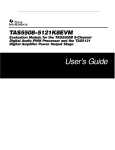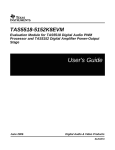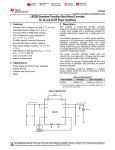Download Texas Instruments TAS5727 User's Manual
Transcript
User's Guide SLOU299 – December 2010 TAS5727 25W Digital Input Amplifier with EQ and 2-Band DRC This manual describes the operation of the TAS5727EVM to evaluate the performance of the TAS5727 integrated digital audio power amplifier. The main contents of this document are: • How to properly connect a TAS5727 Evaluation Module (EVM) and the details of the EVM • How to install and use the GUI to program the TAS5727EVM • How to use the audio processing features such as EQ and Dynamic Range Control (DRC) • Quick-Start Guide for the common modes in which TAS5727EVM can be used 1 2 3 4 5 Contents Overview ..................................................................................................................... 2 1.1 TAS5727EVM and MC57xxPSIA Features ..................................................................... 3 Installation .................................................................................................................... 3 2.1 EVM Installation .................................................................................................... 3 2.2 Software Installation ............................................................................................... 5 Using the EVM Software ................................................................................................... 8 3.1 Connect the GUI to the EVM ..................................................................................... 8 3.2 I2C Memory Tool ................................................................................................... 8 3.3 Volume Function ................................................................................................... 9 3.4 Biquad GUI ......................................................................................................... 9 3.5 DRC GUI ........................................................................................................... 10 Jumpers and Control Utilities on MC57xxPSIA board ................................................................ 13 4.1 RCA/OPTICAL Jumpers ......................................................................................... 13 4.2 Switches ........................................................................................................... 13 4.3 LED Indicators .................................................................................................... 13 Board Layouts, Bill of Materials, and Schematic ...................................................................... 14 5.1 TAS5727EVM and MC57xxPSIA Board Layouts ............................................................ 14 5.2 Bill of Materials .................................................................................................... 15 5.3 Schematics ........................................................................................................ 16 List of Figures 1 2 3 4 5 6 7 8 9 10 11 ..................................................................................... Complete System and EVM Signal Path Overview .................................................................... General Connection Picture ............................................................................................... Connecting TAS5727EVM to MC57xxPSIA ............................................................................. BTL Connection ............................................................................................................. Process Structure ........................................................................................................... Main GUI Display ........................................................................................................... Memory Tool Window ...................................................................................................... Volume Control .............................................................................................................. Selecting Biquad GUI....................................................................................................... Biquad GUI Window....................................................................................................... TAS5727EVM Printed-Circuit Board 2 2 3 4 5 7 8 8 9 9 10 Equibit is a trademark of Texas Instruments. I2C is a trademark of Philips Corporation. SLOU299 – December 2010 Submit Documentation Feedback TAS5727 25W Digital Input Amplifier—with EQ and 2-Band DRC © 2010, Texas Instruments Incorporated 1 Overview www.ti.com 12 DRC Options ............................................................................................................... 11 13 Advanced DRC Options .................................................................................................. 11 14 TAS5727EVM Top Composite Assembly .............................................................................. 14 15 MC57xxPSIA Top Composite Assembly ............................................................................... 14 List of Tables 1 1 Recommended Power Supplies........................................................................................... 4 2 Bill of Materials for TAS5727EVM ...................................................................................... 15 Overview The TAS5727EVM evaluation module demonstrates the TAS5727 device from Texas Instruments. The TAS5727 combines a high-performance PWM processor with a class-D audio power amplifier. This EVM can be configured with two bridge-tied loads (BTL) (2.0). For detailed information about the TAS5727EVM device, review the (device data sheet SLOS637). The Pulse Width Modulator (PWM) is based on TI's Equibit™ technology. The TAS5727 has additional audio processing features like 3D, Bass Boost and 2-band DRC. The EVM software, with its graphic user interface (GUI), facilitates evaluation by providing access to the TAS5727EVM registers through a USB port. See the Using the EVM Software section for further details. Figure 1. TAS5727EVM Printed-Circuit Board The EVM together with other TI components on this board, is a complete 2.0-channel digital audio amplifier system. The MC57XXPSIA Controller board includes a USB interface, a digital input (SPDIF), analog inputs via the ADC, power inputs, and other features like a mute function and power down. MC57xxPSIA TAS5727 EVM Left PC Interface Right SPDIF/ Optical, Coax TAS5727 2CH Analog Input From Other Source/ Digital Out PBTL Figure 2. Complete System and EVM Signal Path Overview 2 TAS5727 25W Digital Input Amplifier—with EQ and 2-Band DRC © 2010, Texas Instruments Incorporated SLOU299 – December 2010 Submit Documentation Feedback Installation www.ti.com 1.1 TAS5727EVM and MC57xxPSIA Features • • • • • • • • 2 Channel evaluation module design Self-contained protection systems and control pins USB interface Standard I2S data input using optical or coaxial inputs Analog input through analog-to-digital converter Subwoofer connection—the PWM terminal provides the PWM signal and power to an external subwoofer board Double-sided, plated-through PCB, 1oz copper, 2mm Access to control signal gain and data format through EVM-software GUI Installation This section describes the EVM and software installation. 2.1 EVM Installation 5V Supply for System Power Coaxial SPDIF Input Analog In to ADC Optical SPDIF Input USB Port Speaker Out A & B 8V–26V Supply for Output Power Speaker Out PBTL Speaker Out C & D Figure 3. General Connection Picture The following are the basic tools for the initial EVM power up. • 5V, 1A power supply (VIN) • 8–26V, 4A power supply (PVDD) • Banana-plug test leads for power supplies and speakers • Optical or coaxial cable for SPDIF interface based on signal source • USB cable • EVM software • Two 8Ω speakers or loads The following sections describe the TAS5727EVM board in regards to power supply (PSU) and system interfaces. SLOU299 – December 2010 Submit Documentation Feedback TAS5727 25W Digital Input Amplifier—with EQ and 2-Band DRC © 2010, Texas Instruments Incorporated 3 Installation 2.1.1 www.ti.com Connecting the TAS5727EVM to MC57xxPSIA On the right side of the MC57xxPSIA is a terminal block and another on the left of the TAS5727EVM (labeled J1). Carefully place the MC57xxPSIA block above the TAS5727EVM block and gently push down. Figure 4. Connecting TAS5727EVM to MC57xxPSIA 2.1.2 PSU Interface The TAS5727EVM is powered by two power supplies connected to the MC57xxPSIA controller board: a 5V power supply (VIN), and a 8V-to-26V (PVDD) power supply. The 3.3V level is generated from the 5V supply by an on-board voltage regulator. NOTE: The power-supply cable length must be minimized. Increasing the length of the PSU cable increases the distortion of the amplifier at high output levels and low frequencies. The maximum output-stage supply voltage depends on the speaker load resistance. See the recommended maximum supply voltage in the TAS5727EVM data sheet. Table 1. Recommended Power Supplies Voltage Limitations (8-Ω Load) Current Recommendations System power supply Description 5V 1A Output power stage supply 8–26V 4A (1) (1) 2.1.3 The rated current corresponds to two channels, full scale. Loudspeaker Connectors CAUTION All speaker outputs are biased at Vcc/2 and must not be connected to ground (e.g., through an oscilloscope ground). Loudspeaker connections vary by device setup. When connecting a speaker in BTL mode, connect the speaker’s two terminals (A and B or C and D) across two outputs on the TAS5727EVM. Speakers or loads can be connected to the outputs A-D with clip leads, or cables can be made with female connectors (JST VHR-2N) that can mate to male connectors on the EVM board. 4 TAS5727 25W Digital Input Amplifier—with EQ and 2-Band DRC © 2010, Texas Instruments Incorporated SLOU299 – December 2010 Submit Documentation Feedback Installation www.ti.com + OUT A – OUT B Figure 5. BTL Connection 2.1.4 USB Interface The TAS5727 registers are accessed through I2C™ bus lines SDA and SCL. The USB circuit and USB connector on the MC57xxPSIA board facilitates the connection between a host computer and the device. The EVM USB circuit is powered by the 5V USB line of the host PC and is independent of the power supplies available on the board. The USB device that is used is a TAS1020B from Texas Instruments. 2.1.5 Digital Audio Interface SPDIF The Digital Audio Interface SPDIF (RCA/OPTO) accepts digital audio data using the I2S protocol. See the TAS5727 data sheet for more information. The RCA connector and the OPTO connector are the two SPDIF interfaces on the MC57xxPSIA board. The switch S3 toggles between the OPTO and RCA connector to accommodate the signal source. When the RCA cable or optical cable is connected and the signal source is powered up, verify that the SPDIF lock indicator (blue LED5) illuminates, confirming that a viable signal is available to the device. Install a jumper on JP4 across the middle pin and the pin marked SPDIF to connect the digital source to SDIN1. Install a jumper on JP5 to connect the digital source to SDIN2. For detailed information on how the data and clocks are provided to the TAS5727, see the schematic appearing at the end of this document and the DIR9001 device data sheet (SLES198). 2.1.6 ADC Interface In the absence of a digital signal source, the PCM1808 ADC can be used to convert an analog audio signal to a digital signal to the TAS5727. The DIR9001 still provides clock signals to the ADC in this process. A 12MHz crystal is installed on the MC57xxPSIA board. The ADC is an additional feature of this board to provide flexibility in sourcing an audio signal to the TAS5727. Review the PCM1808 data sheet (SLES177) for a detailed description of the ADC on this EVM. Install the jumper on JP4 across the middle pin and the pin marked ADC to select ADC as the source for SDIN1. 2.1.7 Board Power-Up General Guidelines Connect theMC57xxPSIA and the TAS5727EVM boards by locating pin 1 on each board, indicated by a small white triangle. TheMC57xx plugs down onto the TAS5727EVM board (i.e., the TAS5727EVM board fits underneath the MC57xxPSIA board). Pin 1 on each board must be connected to each other. Install the EVM software on the PC before powering up the board. After connecting the loudspeakers or other loads, power supplies, and the data line, power up the 5V power supply first; then power up the PVDD power supply. It is recommended initially to set the PVDD level to 10V, then ramp it up to 20V to verify cable connections. 2.2 Software Installation Download the TAS57x UI from the TI Web site. The TI Web site always has the latest release and any updates to versions of the GUI. SLOU299 – December 2010 Submit Documentation Feedback TAS5727 25W Digital Input Amplifier—with EQ and 2-Band DRC © 2010, Texas Instruments Incorporated 5 Installation www.ti.com Execute the GUI install program, Setup.exe. Once the program is installed, the program group and shortcut icon is created in Start → Program → Texas Instruments Inc → TAS57x UI. The GUI launches as shown in Figure 7. The TAS5717 tab opens when the GUI starts. Select Devices → TAS57XX → TAS5727 to open the TAS5727 tab. This tab has two subwindows. One shows the Process Flow window. From the Process Flow window, each of the signal-processing function tools can be selected by clicking on it. The Biquad GUI and the DRC GUI can be opened by right-clicking. This window also shows Input select, Mode select, Channel, and Master Volume. All functions are shown in the same order as in the device. The other subwindow, the Properties window, has the properties that a user can update by selecting from the available options. The properties available depend on the device selected. 6 TAS5727 25W Digital Input Amplifier—with EQ and 2-Band DRC © 2010, Texas Instruments Incorporated SLOU299 – December 2010 Submit Documentation Feedback SLOU299 – December 2010 Submit Documentation Feedback R L 1BQ 30 1BQ 26 0x77 0x76 0x73 0x72 9BQ 31–39 9BQ 27–2F © 2010, Texas Instruments Incorporated 2BQ 5A, 5B 2BQ 5E, 5F 2BQ 5C, 5D 2BQ 58, 59 0x75 0x74 v2im1 0x71 0x70 2 Vol Vol Vol2 Vol1 0x46[1] 0x46[0] Vol Config Reg 0x0E AGL AGL I C Subaddress in Red 0x52[0] 0x52[1] 0x51[0] 0x51[1] 2 2 32 Level Meter clip24 clip24 2 I C:0x6B (32Bit-Left Level) 32 32 32 I C:0x6C (32 Bit-Right Level) I C:57 VDISTB 2 I C:56 VDISTA B0321-11 24 24 www.ti.com Installation Figure 6. Process Structure TAS5727 25W Digital Input Amplifier—with EQ and 2-Band DRC 7 Using the EVM Software www.ti.com Figure 7. Main GUI Display 3 Using the EVM Software 3.1 Connect the GUI to the EVM Open the GUI by clicking Start → All Programs → Texas Instruments Inc → TAS57x → TAS57x GUI. Connect the MC57xxPSIA board (attached to the TAS5717EVM) to your PC with a USB cable. In the Properties window, select 1-band or 2-band DRC and select Stereo or Woofer. Stereo is selected for BTL and Woofer is selected for PBTL Mode. The master volume is muted by default. Select the master volume block. Type the required volume in the Properties window. Connect the GUI to the EVM hardware by clicking Target → Connect. This sends the initialization commands to the device. Un-check Shutdown and Mute. At this time, if connected properly, audio plays through the device. When the Connect command is issued, if an error appears indicating a USB problem, check the connections, and press the USB RESET button on the controller board. Then disconnect and re-connect from the Target menu. 3.2 I2C Memory Tool This tool can be opened from GDE (Tools → I2C Memory Tool) or independent of GDE from Start → Program → Texas Instruments Inc → Memory Tool. Select I2C as shown in Figure 8. Figure 8. Memory Tool Window 8 TAS5727 25W Digital Input Amplifier—with EQ and 2-Band DRC © 2010, Texas Instruments Incorporated SLOU299 – December 2010 Submit Documentation Feedback Using the EVM Software www.ti.com I2C registers can be written or read using this tool. The I2C command file can be sent by selecting the command file and Execute command. 3.3 Volume Function The Individual and Master volume can be selected, and the required volume value can be entered in the Properties window after selecting the function with the mouse (see Figure 9). Figure 9. Volume Control 3.4 Biquad GUI Using the left mouse button, select the PEQ block. In the Properties window, change BiQuadSrc to BIQUAD GUI. Then double-click on the PEQ block as shown in Figure 10. The Biquad GUI window will pop up (Figure 11). Figure 10. Selecting Biquad GUI SLOU299 – December 2010 Submit Documentation Feedback TAS5727 25W Digital Input Amplifier—with EQ and 2-Band DRC © 2010, Texas Instruments Incorporated 9 Using the EVM Software www.ti.com Figure 11. Biquad GUI Window A check mark selects the Biquad. If not selected, the Biquad is in ALL PASS Mode. The frequency response and phase response plots for the current settings can be viewed and adjusted in the Frequency Response and Phase Response panes of the Biquad GUI as shown in Figure 11. The individual Biquad gains must be within ±12db. Clicking the Apply & Draw button sends all three banks of coefficients to the Frequency Response and Phase response plots (providing auto bank is enabled). 3.5 DRC GUI The TAS5727 supports 1-band and 2-band DRC. Select one of the DRC modes from the Properties window. Then set the DRC threshold for each band by double-clicking the UPPERBAND or LOWERBAND block and adjusting the sliders as shown in Figure 12. 10 TAS5727 25W Digital Input Amplifier—with EQ and 2-Band DRC © 2010, Texas Instruments Incorporated SLOU299 – December 2010 Submit Documentation Feedback Using the EVM Software www.ti.com Figure 12. DRC Options The crossover frequency for the 2-band DRC by default is 300Hz. This can be modified by entering a new value in the property window. The DRC rates for the softening filter, attack, and release can also be adjusted. To set these rates, first click on the UPPERBAND or LOWERBAND block. Second, set the RateSliders property to On for that block. Third, double-click on the block to bring up an advanced DRC options window, as shown in Figure 13. Figure 13. Advanced DRC Options PBTL Mode: To run the device in PBTL Mode, the PBTL pin must be driven high. Then in the GUI, select woofer instead of stereo (stereo is the default value). The source for PBTL is selected as (L+R)/2, but that be changed by updating input mixer values. SLOU299 – December 2010 Submit Documentation Feedback TAS5727 25W Digital Input Amplifier—with EQ and 2-Band DRC © 2010, Texas Instruments Incorporated 11 Using the EVM Software 3.5.1 www.ti.com MODULATION SCHEMES Using The FAULT PIN As An Error Indicator: The A_SEL_FAULTZ pin is the I2C device address select by default. To re-define this pin as an output, write '1' to bit D1 of reg 0X05. Once re-programmed as output, this pin indicates a fault condition. Output will go low for Overcurrent (OC) or undervoltage (UVP) error or overtemperature error (OTE) or overvoltage error Common Configurations: 1. 2 × BTL BD Mode 2. 2 × BTL AD Mode Note: AD: AD Modulation-Outputs are 180° out of phase BD: BD Modulation BTL: Bridge-Tied Load 3.5.1.1 1. 2. 3. 4. 2 X BTL BD (BD mode) Set up the hardware. Select the Input MUX from GDE. In the Properties window, select BD Mode. GDE: Target > Connect. Finally uncheck the shutdown box to bring the device out of Shutdown mode, and adjust the Master Volume as desired. 3.5.1.2 1. 2. 3. 4. 2 X BTL AD (Default: AD mode) Set up the hardware. Select the Input MUX from GDE. In the Properties window, select AD Mode. GDE: Target > Connect. Finally uncheck the shutdown box to bring the device out of Shutdown mode, and adjust the Master Volume as desired. 12 TAS5727 25W Digital Input Amplifier—with EQ and 2-Band DRC © 2010, Texas Instruments Incorporated SLOU299 – December 2010 Submit Documentation Feedback Jumpers and Control Utilities on MC57xxPSIA board www.ti.com 4 Jumpers and Control Utilities on MC57xxPSIA board 4.1 RCA/OPTICAL Jumpers Select the jumper to reflect the source whether it is RCA or OPTICAL. 4.2 Switches JP1 on the daughter card is for PBTL select. Jumper IN means non-PBTL mode. For PBTL, remove this jumper. Reset is an active-low function. Pressing the master reset switch (S2) resets the TAS5727 device; USB RESET (S1) resets the USB bus. Pressing PDNZ (S4) powers down the TAS5727, and pressing MUTE (S5) mutes (volume mute) the TAS5727. 4.3 LED Indicators LED1 : USB Power connector installed at J1 LED2 : 3.3V Power is valid LED3: RCA connection made LED4: Optical connection made LED5: SPDIF signal locked LED6: FAULT (This LED should be ignored until FAULT is programmed to be an output via I2C write to reg 0X05.) LED7: PDN switch (S4) is pressed (closed) SLOU299 – December 2010 Submit Documentation Feedback TAS5727 25W Digital Input Amplifier—with EQ and 2-Band DRC © 2010, Texas Instruments Incorporated 13 Board Layouts, Bill of Materials, and Schematic 5 Board Layouts, Bill of Materials, and Schematic 5.1 TAS5727EVM and MC57xxPSIA Board Layouts www.ti.com Figure 14. TAS5727EVM Top Composite Assembly Figure 15. MC57xxPSIA Top Composite Assembly 14 TAS5727 25W Digital Input Amplifier—with EQ and 2-Band DRC © 2010, Texas Instruments Incorporated SLOU299 – December 2010 Submit Documentation Feedback Board Layouts, Bill of Materials, and Schematic www.ti.com 5.2 Bill of Materials Table 2. Bill of Materials for TAS5727EVM Manufacturer Part No. Qty Ref Des Vendor Part No. Description Vendor Manufacturer TEXAS INSTRUMENTS TEXAS INSTRUMENTS TI-SEMICONDUCTORS TAS5727PHP 1 U1 TAS5727PHP 20W DIGAMP WITH DAP HTQFP48-PHP ROHS GRM1885C1H331JA01D 4 C25, C26, C27, C28 490-1439-1 CAP SMD0603 CERM 330PFD 50V 5% COG ROHS DIGI-KEY MURATA GRM188R71H222KA01D 1 C9 490-1500-1 CAP SMD0603 CERM 2200PFD 50V 10% X7R ROHS DIGI-KEY MURATA GRM188R71H472KA01D 2 C6, C8 490-1506-1 CAP SMD0603 CERM 4700PFD 50V 10% X7R ROHS DIGI-KEY MURATA GRM188R71H333KA61D 4 C10, C14, C18, C20 490-3286-1 CAP SMD0603 CERM 0.033UFD 50V 10% X7R ROHS DIGI-KEY MURATA GRM188R71C473KA01D 2 C5, C7 490-1529-1 CAP SMD0603 CERM 0.047UFD 16V 10% ROHS DIGI-KEY MURATA C0603C104K8RACTU 4 C2, C4, C11, C12 399-1095-1 CAP SMD0603 CERM 0.1UFD 10V 5% X7R ROHS DIGI-KEY KEMET GRM188R71H104KA93D 2 C15, C22 490-1519-1 CAP SMD0603 CERM 0.1UFD 50V 10% X7R ROHS DIGI-KEY MURATA TMK107BJ105KA 1 C13 587-1248-1 CAP SMD0603 CERM 1.0UFD 25V 10% X5R ROHS DIGI-KEY TAIYO YUDEN C1206C684K5RACTU 4 C19, C21, C29, C30 445-4013-1 CAP SMD1206 CERM 0.68UFD 50V 10% X7R ROHS DIGI-KEY TDK C1608X5R0J475M 1 C3 445-1417-1 CAP SMD603 CERM 4.7UFD 6.3V 20% X5R ROHS DIGI-KEY TDK EEE1CA100SR 1 C1 PCE3878CT CAP SMD ELECT 10ufd 16V 20% VS-B ROHS DIGI-KEY PANASONIC TMK316B7106KL-TD 4 C16, C17, C23, C24 587-2399-1 CAP SMD1206 CERM 10UFD 25V 10% X7R ROHS DIGI-KEY TAIYO YUDEN ERJ-3GEY0R00V 1 R3 P0.0GCT RESISTOR SMD0603 0.0 OHM 5% THICK FILM 1/10W ROHS DIGI-KEY PANASONIC ERJ-3GEYJ180V 4 R10, R11, R12, R13 P18GCT RESISTOR SMD0603 18 OHMS 5% 1/10W ROHS DIGI-KEY PANASONIC ERJ-3GEYJ471V 2 R7, R8 P470GCT RESISTOR SMD0603 470 OHMS 5% 1/10W ROHS DIGI-KEY PANASONIC ERJ-3EKF1002V 3 R4, R6, R9 P10.0KHCT RESISTOR SMD0603 10.0K 1% THICK FILM 1/10W ROHS DIGI-KEY PANASONIC RMCF0603FT15K0 2 R2 RMCF0603FT15K 0CT RESISTOR SMD0603 15.0K OHMS 1% 1/10W ROHS DIGI-KEY STACKPOLE ELECTRONICS RC0603FR-0718K2L 1 R5 311-18.2KHRCT RESISTOR SMD0603 THICK FILM 18.2K 1% 1/10W ROHS DIGI-KEY YAGEO TOKO JAPAN TOKO JAPAN CAPACITORS RESISTORS INDUCTORS DG6045C-150M 4 L1, L2, L3, L4 DG6045C-150M INDUCTOR SMT 15uH X.XA X.X mOHMS 20% DG6045C ROHS PBC02SAAN 1 JP1 S1011E-02 HEADER THRU MALE 2 PIN 100LS GOLD ROHS DIGI-KEY SULLINS PBC09DAAN 1 J1 S2011E-09 HEADER THRU MALE 2X9 100LS GOLD ROHS DIGI-KEY SULLINS B2PS-VH(LF)(SN) 3 OUT, OUTAB, OUTCD 455-1648 JACK JST-VH RA 2-PIN 3.96mmLS ROHS DIGI-KEY JST SPC02SYAN 1 JP1(2-3) S9001 SHUNT, BLACK AU FLASH 0.100LS DIGI-KEY SULLINS HEADERS AND JACKS SHUNTS STANDOFFS, HARDWARE, WIRE PMS 440 0025 PH 4 NA H342 4-40 SCREW, STEEL 0.250 IN DIGI-KEY BUILDING FASTENERS 2029 4 NA 2029K STANDOF ,4-40 0.75IN 3/16IN DIA ALUM RND F-F DIGI-KEY KEYSTONE ELECTRONICS C2040V-100 2 JP1 C2040V-100 WIRE GRAY STRANDED 20AWG 20mm LENGTH ROHS DIGI-KEY GENERAL CABLE Component Count: 63 SLOU299 – December 2010 Submit Documentation Feedback TAS5727 25W Digital Input Amplifier—with EQ and 2-Band DRC © 2010, Texas Instruments Incorporated 15 PGND 10.0K 0603 R4 PGND TAS5727 25W Digital Input Amplifier—with EQ and 2-Band DRC © 2010, Texas Instruments Incorporated MCLK DVDD 1.0in 1.0in 1.0in PGND PGND PGND PGND 1.0in STANDOFFS 18 17 10.0K 0603 R6 SDA SCL LRCLK SCLK SDIN PGND R5 PGND 0.1ufd/10V 0603 C4 18.2K 0603 PGND 0.1ufd/10V 0603 C2 AVSS 10ufd/16V VS-B C1 4.7ufd/6.3V 0603 AVDD PGND PGND MCLK R3 0.0 0603 + C3 PGND AVDD 15 PVDD SDA SCL SDIN LRCLK SCLK AVDD 15.0K 0603 R2 16 14 13 12 11 10 9 8 7 6 5 4 3 2 1 J1 FROM MC57xxPSIA DNP 0603 R1 AVDD 11 33 34 36 U1 9 8 7 6 C12 HTQFP48-PHP C13 TAS5727PHP U1 470 0603 5 4 C14 3 2 0.033ufd/50V 0603 1 39 40 41 42 43 44 45 46 47 48 PGND C22 0.033ufd/50V 0603 C20 PGND 10ufd/25V 1206 C16 PVDD PGND 10ufd/25V 1206 C17 PGND 330pfd/50V 0603 C26 18 0603 R11 PGND 330pfd/50V 0603 C25 18 0603 R10 C23 C24 PVDD PVDD_B/C CAN BE UNROUTED AT USERS DISCRETION 0.033ufd/50V 0603 C18 PGND PGND 0.1ufd/50V 0603 C15 PGND PGND 0.1ufd/10V 0603 C11 DVDD 0.1ufd/10V 0603 PGND HTQFP48-PHP PowerPad PGND PGND 1.0ufd/25V 0603 0.033ufd/50V 0603 38 37 23 24 22 PGND 0.1ufd/50V 0603 PGND 10ufd/25V 1206 PGND 10ufd/25V 1206 PGND 330pfd/50V 0603 C28 18 0603 R13 PGND 330pfd/50V 0603 C27 21 2728 31 32 35 10 0.047ufd/16V 0603 R8 C10 PGND 18 0603 26 2930 470 0603 C7 C9 2200pfd/50V 0603 R12 25 12 0.047ufd/16V 0603 R7 4700pfd/50V 0603 AVSS 4700pfd/50V 0603 PGND 10.0K 0603 R9 20 19 18 17 16 15 14 13 1 2 C8 JP1 C6 C5 IN=BTL OUT=PBTL 10mm 10mm 1 2 16 1 JP3 JP2 IN=PBTL OUT=BTL IN=PBTL OUT=BTL L1 15uH DG6045C L4 15uH DG6045C L3 15uH DG6045C L2 15uH DG6045C PGND 0.68ufd/50V 1206 C30 PGND 0.68ufd/50V 1206 C29 PGND 0.68ufd/50V 1206 C21 PGND 0.68ufd/50V 1206 C19 1 OUT 2 1 BTL JST-VH2-RA OUTD OUTCD PBTL JST-VH2-RA 1 2 BTL OUTC A+B C+D 2 JST-VH2-RA OUTA OUTB OUTAB ANALOG OUTPUTS 5.3 2 AVDD Board Layouts, Bill of Materials, and Schematic www.ti.com Schematics The schematic for TAS5727EVM follows. The schematics for MC57xxPSIA appear on the following pages. SLOU299 – December 2010 Submit Documentation Feedback Board Layouts, Bill of Materials, and Schematic SLOU299 – December 2010 Submit Documentation Feedback USB I/O (A0 IN DEFAULT) USB BOOT EPROM USB INTERFACE USB RESET DECOUPLING U3 TAS1020BPFB TO EVM BOARD ENGINEERING EVALUATION ONLY www.ti.com TAS5727 25W Digital Input Amplifier—with EQ and 2-Band DRC © 2010, Texas Instruments Incorporated 17 18 TAS5727 25W Digital Input Amplifier—with EQ and 2-Band DRC © 2010, Texas Instruments Incorporated 5V POWER INPUT MASTER RESET 1-2: OPTO INPUT 2-3: RCA INPUT SPDIF INPUT SELECT SPDIF INPUT SPDIF RECEIVER TO ADC 3.3V@1A OPTO INPUT (HIGH) RCA INPUT (LOW) JP1 IN: SCKO = 512 Fs JP1 OUT: SCKO = 256 Fs (DEFAULT) TO ADC TO SPDIF TO EVM BOARD DIR9001PW U5 H H FMT1 FMT0 SPDIF DECOUPLING 24Bit/MSB/I2S DATA FORMAT TO EVM BOARD TO ADC SPDIF LOCK ENGINEERING EVALUATION ONLY Board Layouts, Bill of Materials, and Schematic www.ti.com SLOU299 – December 2010 Submit Documentation Feedback SLOU299 – December 2010 Submit Documentation Feedback © 2010, Texas Instruments Incorporated HIGH POWER INPUT FROM VR1 FROM MASETER RESET FROM USB FROM SPDIF ANALOG INPUTS IN: LIN/RIN = 1Vrms MAX. OUT: LIN/RIN = 2Vrms MAX. NOTES ON JUMPERS ADC / CONNECTOR I/O 3.3V DECOUPLING PCM1808PW ADC 5V DECOUPLING (SDIN2) (SDIN1) MUTE PDN FAULT MC012 (1-2) PSIA (2-3) TO EVM BOARDS ENGINEERING EVALUATION ONLY www.ti.com Board Layouts, Bill of Materials, and Schematic TAS5727 25W Digital Input Amplifier—with EQ and 2-Band DRC 19 EVALUATION BOARD/KIT IMPORTANT NOTICE Texas Instruments (TI) provides the enclosed product(s) under the following conditions: This evaluation board/kit is intended for use for ENGINEERING DEVELOPMENT, DEMONSTRATION, OR EVALUATION PURPOSES ONLY and is not considered by TI to be a finished end-product fit for general consumer use. Persons handling the product(s) must have electronics training and observe good engineering practice standards. As such, the goods being provided are not intended to be complete in terms of required design-, marketing-, and/or manufacturing-related protective considerations, including product safety and environmental measures typically found in end products that incorporate such semiconductor components or circuit boards. This evaluation board/kit does not fall within the scope of the European Union directives regarding electromagnetic compatibility, restricted substances (RoHS), recycling (WEEE), FCC, CE or UL, and therefore may not meet the technical requirements of these directives or other related directives. Should this evaluation board/kit not meet the specifications indicated in the User’s Guide, the board/kit may be returned within 30 days from the date of delivery for a full refund. THE FOREGOING WARRANTY IS THE EXCLUSIVE WARRANTY MADE BY SELLER TO BUYER AND IS IN LIEU OF ALL OTHER WARRANTIES, EXPRESSED, IMPLIED, OR STATUTORY, INCLUDING ANY WARRANTY OF MERCHANTABILITY OR FITNESS FOR ANY PARTICULAR PURPOSE. The user assumes all responsibility and liability for proper and safe handling of the goods. Further, the user indemnifies TI from all claims arising from the handling or use of the goods. Due to the open construction of the product, it is the user’s responsibility to take any and all appropriate precautions with regard to electrostatic discharge. EXCEPT TO THE EXTENT OF THE INDEMNITY SET FORTH ABOVE, NEITHER PARTY SHALL BE LIABLE TO THE OTHER FOR ANY INDIRECT, SPECIAL, INCIDENTAL, OR CONSEQUENTIAL DAMAGES. TI currently deals with a variety of customers for products, and therefore our arrangement with the user is not exclusive. TI assumes no liability for applications assistance, customer product design, software performance, or infringement of patents or services described herein. Please read the User’s Guide and, specifically, the Warnings and Restrictions notice in the User’s Guide prior to handling the product. This notice contains important safety information about temperatures and voltages. For additional information on TI’s environmental and/or safety programs, please contact the TI application engineer or visit www.ti.com/esh. No license is granted under any patent right or other intellectual property right of TI covering or relating to any machine, process, or combination in which such TI products or services might be or are used. FCC Warning This evaluation board/kit is intended for use for ENGINEERING DEVELOPMENT, DEMONSTRATION, OR EVALUATION PURPOSES ONLY and is not considered by TI to be a finished end-product fit for general consumer use. It generates, uses, and can radiate radio frequency energy and has not been tested for compliance with the limits of computing devices pursuant to part 15 of FCC rules, which are designed to provide reasonable protection against radio frequency interference. Operation of this equipment in other environments may cause interference with radio communications, in which case the user at his own expense will be required to take whatever measures may be required to correct this interference. EVM WARNINGS AND RESTRICTIONS It is important to operate this EVM within the input voltage range of -0.5V to 4.1V and the output voltage range of 26Vp-p. Exceeding the specified input range may cause unexpected operation and/or irreversible damage to the EVM. If there are questions concerning the input range, please contact a TI field representative prior to connecting the input power. Applying loads outside of the specified output range may result in unintended operation and/or possible permanent damage to the EVM. Please consult the EVM User's Guide prior to connecting any load to the EVM output. If there is uncertainty as to the load specification, please contact a TI field representative. During normal operation, some circuit components may have case temperatures greater than 85°C. The EVM is designed to operate properly with certain components above 85°C as long as the input and output ranges are maintained. These components include but are not limited to linear regulators, switching transistors, pass transistors, and current sense resistors. These types of devices can be identified using the EVM schematic located in the EVM User's Guide. When placing measurement probes near these devices during operation, please be aware that these devices may be very warm to the touch. Mailing Address: Texas Instruments, Post Office Box 655303, Dallas, Texas 75265 Copyright © 2008-2009, Texas Instruments Incorporated IMPORTANT NOTICE Texas Instruments Incorporated and its subsidiaries (TI) reserve the right to make corrections, modifications, enhancements, improvements, and other changes to its products and services at any time and to discontinue any product or service without notice. Customers should obtain the latest relevant information before placing orders and should verify that such information is current and complete. All products are sold subject to TI’s terms and conditions of sale supplied at the time of order acknowledgment. TI warrants performance of its hardware products to the specifications applicable at the time of sale in accordance with TI’s standard warranty. Testing and other quality control techniques are used to the extent TI deems necessary to support this warranty. Except where mandated by government requirements, testing of all parameters of each product is not necessarily performed. TI assumes no liability for applications assistance or customer product design. Customers are responsible for their products and applications using TI components. To minimize the risks associated with customer products and applications, customers should provide adequate design and operating safeguards. TI does not warrant or represent that any license, either express or implied, is granted under any TI patent right, copyright, mask work right, or other TI intellectual property right relating to any combination, machine, or process in which TI products or services are used. Information published by TI regarding third-party products or services does not constitute a license from TI to use such products or services or a warranty or endorsement thereof. Use of such information may require a license from a third party under the patents or other intellectual property of the third party, or a license from TI under the patents or other intellectual property of TI. Reproduction of TI information in TI data books or data sheets is permissible only if reproduction is without alteration and is accompanied by all associated warranties, conditions, limitations, and notices. Reproduction of this information with alteration is an unfair and deceptive business practice. TI is not responsible or liable for such altered documentation. Information of third parties may be subject to additional restrictions. Resale of TI products or services with statements different from or beyond the parameters stated by TI for that product or service voids all express and any implied warranties for the associated TI product or service and is an unfair and deceptive business practice. TI is not responsible or liable for any such statements. TI products are not authorized for use in safety-critical applications (such as life support) where a failure of the TI product would reasonably be expected to cause severe personal injury or death, unless officers of the parties have executed an agreement specifically governing such use. Buyers represent that they have all necessary expertise in the safety and regulatory ramifications of their applications, and acknowledge and agree that they are solely responsible for all legal, regulatory and safety-related requirements concerning their products and any use of TI products in such safety-critical applications, notwithstanding any applications-related information or support that may be provided by TI. Further, Buyers must fully indemnify TI and its representatives against any damages arising out of the use of TI products in such safety-critical applications. TI products are neither designed nor intended for use in military/aerospace applications or environments unless the TI products are specifically designated by TI as military-grade or "enhanced plastic." Only products designated by TI as military-grade meet military specifications. Buyers acknowledge and agree that any such use of TI products which TI has not designated as military-grade is solely at the Buyer's risk, and that they are solely responsible for compliance with all legal and regulatory requirements in connection with such use. TI products are neither designed nor intended for use in automotive applications or environments unless the specific TI products are designated by TI as compliant with ISO/TS 16949 requirements. Buyers acknowledge and agree that, if they use any non-designated products in automotive applications, TI will not be responsible for any failure to meet such requirements. Following are URLs where you can obtain information on other Texas Instruments products and application solutions: Products Applications Amplifiers amplifier.ti.com Audio www.ti.com/audio Data Converters dataconverter.ti.com Automotive www.ti.com/automotive DLP® Products www.dlp.com Communications and Telecom www.ti.com/communications DSP dsp.ti.com Computers and Peripherals www.ti.com/computers Clocks and Timers www.ti.com/clocks Consumer Electronics www.ti.com/consumer-apps Interface interface.ti.com Energy www.ti.com/energy Logic logic.ti.com Industrial www.ti.com/industrial Power Mgmt power.ti.com Medical www.ti.com/medical Microcontrollers microcontroller.ti.com Security www.ti.com/security RFID www.ti-rfid.com Space, Avionics & Defense www.ti.com/space-avionics-defense RF/IF and ZigBee® Solutions www.ti.com/lprf Video and Imaging www.ti.com/video Wireless www.ti.com/wireless-apps Mailing Address: Texas Instruments, Post Office Box 655303, Dallas, Texas 75265 Copyright © 2010, Texas Instruments Incorporated
























